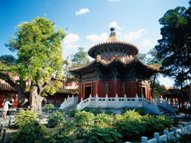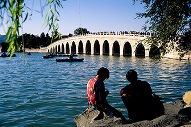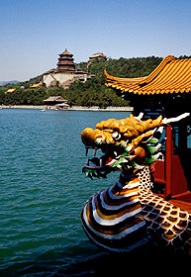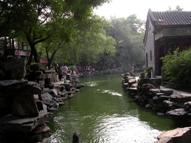This day Beijing tour begins at 09:00am and ends at around 5:00pm. P lease get everything ready before our English-speaking guide comes and meets you in the lobby of the hotel where you stay. Itís about 20 minutes driving to the first stop of the main attractions. lease get everything ready before our English-speaking guide comes and meets you in the lobby of the hotel where you stay. Itís about 20 minutes driving to the first stop of the main attractions.
No matter which site is at the beginning on the title of this day Beijing tour, we would like to begin the tour with Lama Temple. The Lama Temple is the largest Tibetan temple outside Tibet, which may give you a touch of Tibetan culture. Situated in the heart of Beijing, the temple was built in 1694 as the residence of Prince Yong of the Qing Dynasty, who later became Emperor and moved to the Forbidden City in 1723. According to tradition, his residence was converted to a temple and was renamed Yonghe temple after Emperorís name Yongzheng. Yonghe Lamasery covers an area of 66,000 square meters with a combination of mainstream Han and ethnic Tibetan Buddhist architectural styles. There are 1,000 rooms altogether. Five main buildings lying on the north Ė south axis in the temple that are the main attractions: the Gate of Harmony, the Hall of Harmony, the Hall of Eternal Blessing, the Hall of the Wheel of the Law and Wanfuge (Ten Thousand Happiness Pavilion). It takes you about one hour to visit the Lama Temple. was built in 1694 as the residence of Prince Yong of the Qing Dynasty, who later became Emperor and moved to the Forbidden City in 1723. According to tradition, his residence was converted to a temple and was renamed Yonghe temple after Emperorís name Yongzheng. Yonghe Lamasery covers an area of 66,000 square meters with a combination of mainstream Han and ethnic Tibetan Buddhist architectural styles. There are 1,000 rooms altogether. Five main buildings lying on the north Ė south axis in the temple that are the main attractions: the Gate of Harmony, the Hall of Harmony, the Hall of Eternal Blessing, the Hall of the Wheel of the Law and Wanfuge (Ten Thousand Happiness Pavilion). It takes you about one hour to visit the Lama Temple. After the tour of Lama Temple, you will be taken to  the Summer Palace at around 11:00am. The Summer Palace lies about 20 kilometers northwest of Beijing. It is up to now the best preserved and the largest imperial gardens in China. The main features of the Summer Palace are Kunming Lake and Longevity Hill. It has an area of 290 hectares, approximately the size of seven Tiananmen Square. It also boasts more than 3,000 bays of various buildings in different palace and garden architectural styles. Kunming the Summer Palace at around 11:00am. The Summer Palace lies about 20 kilometers northwest of Beijing. It is up to now the best preserved and the largest imperial gardens in China. The main features of the Summer Palace are Kunming Lake and Longevity Hill. It has an area of 290 hectares, approximately the size of seven Tiananmen Square. It also boasts more than 3,000 bays of various buildings in different palace and garden architectural styles. Kunming Lake consists of three fourths of the whole garden. 1.5 or 2 hours are needed for the visit to the Summer Palace. Lake consists of three fourths of the whole garden. 1.5 or 2 hours are needed for the visit to the Summer Palace. 12:30pm, it is time for lunch when you finish seeing the Summer Palace. We would like to offer Beijing day tour with lunch in a local restaurant, which is included in the given price. We also consider that in this way you can learn a lot more about Chinese cuisines during your stay in China. 2 hours are needed for having lunch and driving to the next stop, the Hutongs of old Beijing. One of the unique features of Beijing is its numerous Hutongs, which means small lanes. The life of ordinary people in these lanes contributes greatly to the charm of this ancient capital. In these small lanes, you will find many siheyuan, or quadrangles that are the living quarters of ordinary Beijing locals. Beijingís Hutongs are not only an appellation for the lanes but also a kind of architecture. Itís the living environment of ordinary Beijing locals. It reflects the vicissitude of society. Most of the Hutongs look almost the same with grey walls and bricks. Hutongs are a ha ppy kind of place. There are often 4 to 10 families with an average of 20 people sharing the rooms of one courtyard complex. The main attraction of Hutong life is a friendly and interpersonal communication. Children living in one courtyard play together and grow up like one family. For the elderly, the charm comes from each otherís company. ppy kind of place. There are often 4 to 10 families with an average of 20 people sharing the rooms of one courtyard complex. The main attraction of Hutong life is a friendly and interpersonal communication. Children living in one courtyard play together and grow up like one family. For the elderly, the charm comes from each otherís company. This day tour ends with the transfer back to your hotel at around 5:00pm. We hope that this day tour arrangement just fits your needs and interests. We look forward to hearing from you. |